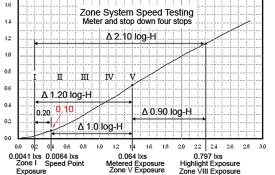Gently put, I believe most of us are already there on this point. And have been for a long while. Many since we were teenagers. Although back then on the street the term ASA was used to refer to both ISO and EI. "Hey... Kodak sez' 400, but what ASA do you shoot your Tri-X at?"
My point is that just because that same most-of-us aren't equipped to replicate the current standardized ISO test protocols in our home darkrooms does not mean that our far less rigorous personal EI tests are therefore useless. Or meaningless. To the contrary, it really is possible to conduct a few simple home-brew tests and end up in a better place knowledge- and technique-wise than we were before testing.
The truth is, I don't need to conduct research at CERN into how the Higgs boson confers mass in the universe to know when I'm carrying too much of it. All I need is the bathroom scale to know when I'm overweight. The existence of the former is certainly not being called into question. Only its applicability to the problem at hand is being questioned. Its fitness to purpose, when that purpose is simply dropping five or ten pounds after the holidays.
When every simplified attempt at home film testing is met with a dismissive attitude that we are all stupidly wasting our time because any test we might engage in is never going to be rigorous enough to satisfy certain poster's definitions of perfection, then it's time for someone to raise their hand and gently disagree.
I gently disagree...
Ken
All I've been saying is that the level of precision with ISO speed testing is far greater than what any photographer can do. It also takes into consideration variables that I'm pretty certain most people don't. What's wrong with using the ISO speed as a knowable starting point. I believe this approach can yield a good working EI fairly quickly.
I'm not advocating ultra-precise testing methods or criticizing people who do their own testing. Although there are good tests and bad tests. Just because someone comes up with a result doesn't automatically make it a good test. How many times has someone claimed that their picture test showed film A was contrastier than film B in a certain developer, yet they never actually determined the contrast / gradient of either film. The obvious answer is that film A was developed to a higher contrast, but unaware our intrepid tester confidently walks away with his new hard earned knowledge. I try to make people aware of the strengths and weaknesses of different methods so they can make an informed decision.
How about Clutter's personal EI test. He didn't indicated his testing method, which is rather important for interpreting results, but my money is on the Zone System (the ISO prefix indicates that the standard was followed so we know how ISO speeds were determined). I've explained and shown multiple times that the Zone System methodology is different from the ISO methodology and the ZS testing will usually result in EIs around 2/3 of a stop slower +/- 1/3 stop. Which appears to be the case in this instance.

(This example is for informational purposes only. It's presence in no way endorses the use of curves in testing.)
Has the personal testing actually determine that the film speed is different from the ISO, or does their test simply use different testing parameters? So what does Zone System testing really tell you that simply opening up 1/2 to 1 stop from the ISO doesn't? How much is a test worth that doesn't produce results that can be trusted or aren't properly evaluated. If they were why are there so many claims about a "true speed" or conspiracy theories about the ISO speed?
I uploaded an exposure vs quality curve earlier and indicated on the curve what could be considered a Goldilocks area. How precise does the exposure have to be if +/- 1/2 stop doesn't make any difference in quality?
What about the results of Clutter's contrast test? This is a separate topic, but in my opinion, determining development is the more essential of the two tests and the test people should be most concerned with. It's also a test that is easily done in any darkroom.
____________________________________________________________________
"This new learning is amazing. Explain to me again how sheep's bladders can be use to prevent earthquakes." - Monty Python and the Holy Grail
 For what it's worth, my tests (using a densitometer) show that I need to meter about half a stop slower than box speed but keep development time the same. For me, this gives Zone I density of 0.11 above FB+F, Zone VIII about 1.29.
For what it's worth, my tests (using a densitometer) show that I need to meter about half a stop slower than box speed but keep development time the same. For me, this gives Zone I density of 0.11 above FB+F, Zone VIII about 1.29. For what it's worth, my tests (using a densitometer) show that I need to meter about half a stop slower than box speed but keep development time the same. For me, this gives Zone I density of 0.11 above FB+F, Zone VIII about 1.29.
For what it's worth, my tests (using a densitometer) show that I need to meter about half a stop slower than box speed but keep development time the same. For me, this gives Zone I density of 0.11 above FB+F, Zone VIII about 1.29.












